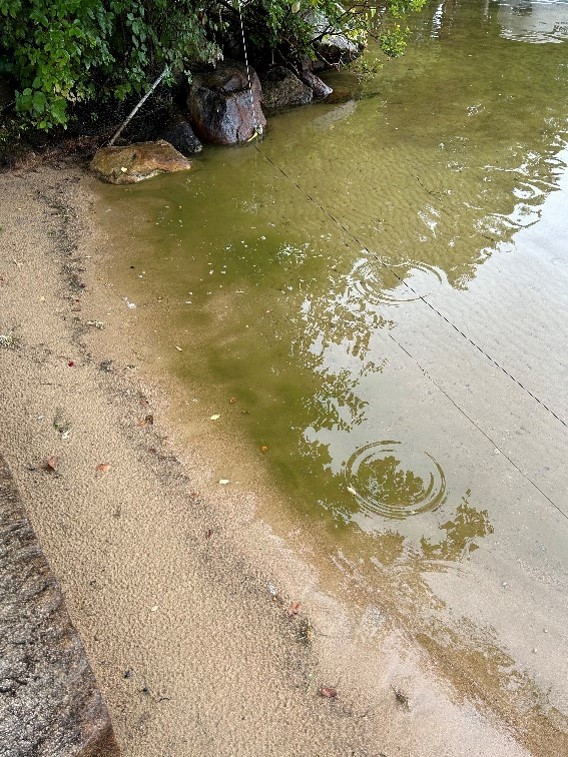By PAULA TRACY, InDepthNH.org
WOLFEBORO – Cyanobacteria watches or warnings are up again on Lake Winnipesaukee for Alton, Wolfeboro, Tuftonboro, The Broads, the area of Governor’s Island along with other water bodies across the state right now.
The state Department of Environmental Services reports a form of cyanobacteria known as gloeotrichia which presents as blobs floating up and down in the water column, are the primary concern on the Big Lake while other water bodies are having some form of cyanobacteria warnings or watches including Lake Wentworth in Wolfeboro and Pool Pond in Rindge.
It notes that the motto is “when in doubt, stay out,” of the water for health reasons for humans and animals. A rash of blooms on Lake Winnipesaukee occurred in mid-June keeping people and pets out of some of the water for about a week or more.
A current and updated state map Wednesday of the 14 cyanobacteria warnings and six watches can be found here, as it changes rapidly. https://www.arcgis.com/apps/dashboards/8d84a6b03acb4efaab571b222c78447b
Kate Hastings, who is program manager and the sole person running the DES’s cyanobacteria program, said “unprecedented” call volume on her phone was necessitating asking people to report possible blooms directly online at this site.https://survey123.arcgis.com/share/151c9fc3c8214c2e93325f77e0f1d578
Water scientists known as limnologists, believe that the warm winter with little ice, the higher water temperature through the summer, surface water runoff and high phosphate all are contributing to a perfect storm with the high number of reported blooms from mid-June returning.
While naturally occurring all over the world, cyanobacteria can grow in concentrations to be toxic. Not all cyanobacteria are toxic. It needs to be tested to see the type and amount. Acute gastro, respiratory adverse reactions, skin rash, oral ulcers, malaise or lethargy and loss of appetite are among the human health effects of cyanobacteria.
For dogs, it could be lethal if they drink it.
Symptoms for dogs include diarrhea or vomiting, drooling, weakness, breathing difficulty, tremors, excessive salivation and a buildup of fluid in the lungs.
A number of watches or warnings were posted on Tuesday for the Big Lake including the Broads and Governor’s Island area while the Alton area has been on the list since Aug. 19.
DES website: Cyanobacteria warnings are issued for generalized areas where harmful cyanobacteria blooms have been recently identified, but the whole waterbody may not be simultaneously impacted.
NHDES cyanobacteria warnings and watches
What is a cyanobacteria warning? Is an watch (alert) different?
Warnings are issued when the cyanobacteria cell density exceeds the recreational health threshold of 70,000 cyanobacteria cells/mL. This density is associated with the level at which cyanotoxins may be present at a concentration that threatens public health. When there is a warning, NHDES advises lake users to avoid contact with the water in the vicinity of a bloom. Pets and livestock should also be kept out of the water. When NHDES issues a warning, lakes are resampled weekly until the bloom subsides. NHDES issues warnings from May 15 through October 15.
Watches (alerts) are issued 1) based on a photo submitted before NHDES can analyze a sample and a bloom that may be health risk is evident; 2) when the cyanobacteria cell density is approaching but does not yet exceed 70,000 cells/mL; or 3) if a bloom is reported, but conditions may have changed. Watches are intended to serve as statements to be on the watch for a potential cyanobacteria bloom. A watch may develop into a warning but otherwise remain active for a week. Resampling only occurs if further bloom reports are submitted. Watches are issued year-round as needed. Waterbody users should avoid contact with bloom material and keep pets and livestock out of the water.
About Gloeotrichia from DES website
The colonies look like very small, fuzzy balls in the water. Each colony of Gloeotrichia may contain approximately 5,000 cells. They can appear either green or sometimes brownish-yellow by eye.
Oftentimes, these cyanobacteria stay suspended in the water and do not accumulate to large concentrations. Under certain conditions, however they can accumulate along shorelines in more dense concentrations of material, occasionally forming green or yellow clouds or surface scums. Oftentimes these accumulations do not last long and become mixed back into the water to lower densities. These blooms can rapidly change and accumulate in various locations around a waterbody. Please monitor your individual shorelines for changing conditions and avoid contact with areas with dense accumulations, please also keep pets out. If the density looks low, the risk of recreating in that water should be low. Some folks compare it to a night sky – if it looks like a starry night, the risk is low, but if it looks like a galaxy consider staying out of the water and keeping pets out.





